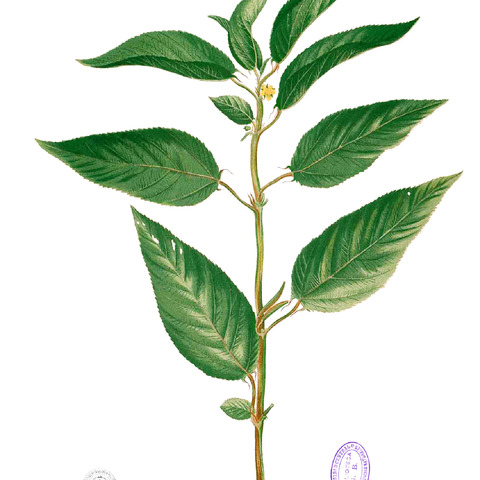Annual or perennial herbs. Leaves alternate, simple, ovate, elliptic, lanceolate or oblong, verrucose above, margins serrate, crenate or dentate, often with a pair of basal setae; petioles pubescent, more so on one side; stipules subulate, pubescent, glabrous or ciliate, rarely stellate-tomentose. Inflorescence of 1–3(–5)-flowered, leaf-opposed fascicles, or cymes of up to 6 flowers; bracts subulate, pilose or glabrous, rarely stellate-tomentose. Sepals 4–5, free, acuminate, cucullate. Petals 4–5, obovate or oblanceolate rarely spathulate, free, yellow. Stamens 5–∞. Ovary cylindric or oblong, rarely spherical, pubescent. Fruit a capsule, solitary or in 2s–5s, cylindric or spherical, straight or slightly curved, splitting into 3–5 valves, often ending in a beak or spreading horns. Seeds angular, dolabriform or oblong-ovoid.
Herbs, annual or perennial, [subshrubs], or shrubs, taprooted. Stems erect to ascending or decumbent, usually unbranched or relatively few-branched, hairy, hairs simple or stellate. Leaves petiolate; stipules caducous to subpersistent, filiform; blade unlobed, oblong to ovate obovate, apically awned or not, glabrous or hairy; petals [4 or]5, yellow, obovate to oblanceolate, glands absent; stamens [4–]10–70[–100], on androgynophore; ovary 2–4[–10]-locular; ovules 2–50 per locule; styles 1, simple, short-cylindric; stigmas peltate or discoid, usually irregularly crenulate or lobulate. Capsules usually cylindric to short-ellipsoid, rarely subglobose, 2–4[–10]-valved, glabrous or hairy, dehiscence loculicidal. Seeds 4–10[–30] per locule, angular, smooth or pitted. x = 7.
Herbs or subshrubs. Leaves petiolate; stipules filiform; leaf blade papery, basal veins usually 3, usually with linear appendages at or near base, margin serrate, serrulate, or crenate. Flowers solitary or several arranged in cymes, axillary or extra-axillary, bisexual, yellow. Sepals 4 or 5. Petals 4 or 5; glands absent. Stamens 15 to many, on androgynophore, free; staminodes absent. Ovary 2-5-loculed; ovules many per locule; style short; stigma peltate or disk-shaped, entire or lobed. Fruit a capsule, cylindrical or globose, sometimes angled, 2-5-valved, loculicidally dehiscent. Seeds many.
Leaves alternate, serrate, dentate, repand or lobed, with the basal teeth often prolonged into long setaceous points; petiole usually more densely pubescent on the upper side; stipules lateral, usually setaceous or subacute.
Fruit an elongated or subglobose capsule, glabrous or hairy, smooth, bristly or prickly, straight or curved, loculicidally 2–5-valved, sometimes with transverse septa within, 2-to many-seeded.
Seeds dark brown or black, pendulous or horizontal, quadrate, ellipsoid, cylindric or irregularly hemispherical; embryo usually curved; cotyledons flat; endosperm fleshy.
Ovary 2–5-locular, with 2 to many axile ovules in each chamber; style glabrous, with a cup-shaped or slightly 2–6-lobed or capitate-fimbriate stigma.
Herbs or small shrubs, sometimes with annual stems from a woody rootstock, with simple or stellate hairs.
Petals yellow, obovate, oblanceolate or linear, usually with a short ciliolate basal claw.
Ovary borne on a very short glabrous androgynophore which is annular at its apex.
Stamens 7 to many, filamentous, arising between the annulus and ovary.
Inflorescences of bracteate pedunculate cymes ± opposite the leaves.
Sepals 4–5, usually narrow, often caudate at the apex.
Flowers bisexual.

